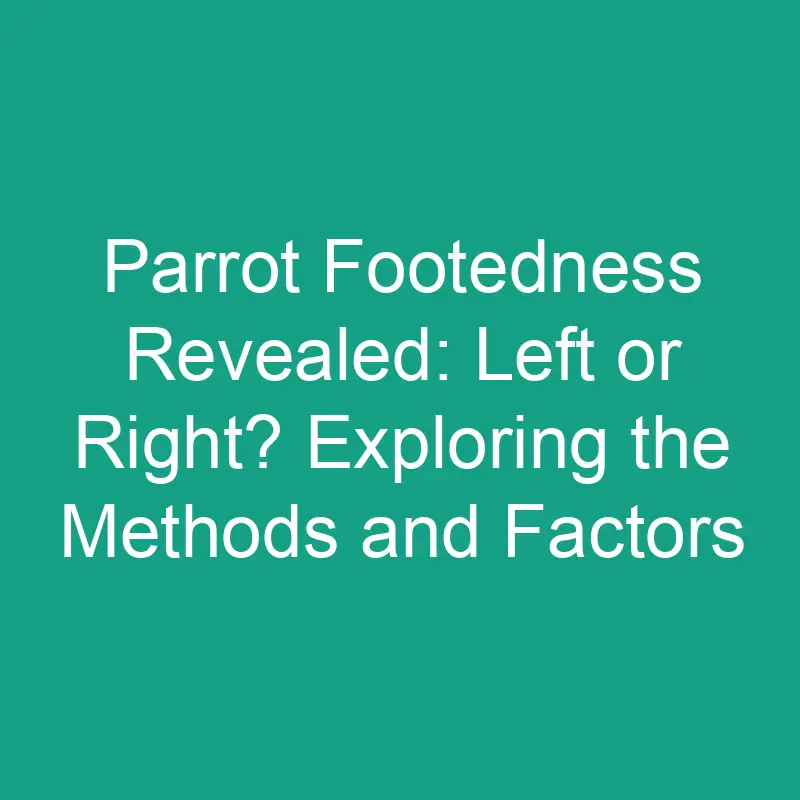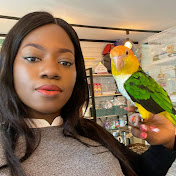
Parrots, with their vibrant plumage and remarkable intelligence, have long fascinated humans. But have you ever wondered if these colorful birds have a preference when it comes to which foot they use more often? In this article, I’ll delve into the intriguing question of whether parrots are left or right footed.
As a parrot enthusiast myself, I’ve spent countless hours observing and studying these fascinating creatures. And let me tell you, their footedness is definitely an interesting aspect to explore. While some animals, like humans, clearly favor one hand over the other, determining footedness in parrots is a bit more complex.
So, if you’re curious to know whether parrots have a dominant foot and what factors might influence it, join me as we unravel the mysteries of parrot footedness. It’s time to dive into the world of these magnificent birds and discover the truth behind their left or right preference.
Key Takeaways
- Parrots exhibit footedness, which refers to their preference for using one foot over the other for dexterity tasks.
- Determining footedness in parrots is more complex than in humans due to their unique anatomy and use of beak and feet for interaction.
- Observing parrot behavior using methods like first foot used, balancing foot, and picking up objects can help determine footedness.
- Parrot footedness can be influenced by species, individual preference, and task complexity.
- Factors like genetic factors, early learning experiences, and the bird’s personality can influence individual parrot footedness.
- The left or right footed parrot debate is ongoing, and there is no definitive consensus on whether parrots are truly left or right-footed.
What is Footedness?
Footedness, also known as laterality, refers to the preference of an individual to use one foot over the other for activities that require dexterity and precision. In other words, it is the dominance of either the left or right foot in performing certain tasks.
While footedness is commonly associated with humans, it is not exclusive to our species. Many animals, including parrots, exhibit footedness as well. However, determining footedness in parrots is a bit more complex compared to humans.
In humans, footedness can be easily observed by noticing which foot an individual prefers to use while walking, kicking a ball, or even just standing. However, parrots primarily use their beak and feet to interact with their environment, making it more challenging to determine their preferred foot. Additionally, parrots have a unique anatomy, with two toes pointing forward and two toes pointing backward on each foot, further complicating the analysis.
Despite these challenges, researchers have been studying parrot footedness to unravel the mysteries behind their preferred foot. Studies have used various methods such as observing which foot the parrot uses to step first, assessing the foot used to pick up items or balance on a perch, and even studying brain lateralization patterns in relation to foot preference.
Understanding footedness in parrots can provide valuable insights into their behavior, cognitive abilities, and evolutionary history. It can also help parrot owners and enthusiasts better understand their feathered companions and provide them with appropriate enrichment and training.
Observing Footedness in Parrots
When it comes to determining whether parrots are left or right footed, observing their behavior is key. As an experienced blogger, I can guide you through the different methods researchers have used to study footedness in these fascinating birds.
Method 1: First Foot Used
One method researchers use is observing which foot the parrot uses first. This involves placing an object just out of reach and noting which foot the parrot extends first to try and grab it. repeated trials can provide valuable insights into the parrot’s preferred foot.
Method 2: Balancing Foot
Another way to assess footedness in parrots is by observing the foot they use for balancing. Parrots often use one foot to stabilize themselves while perching or maneuvering. By carefully observing their behavior in various situations, researchers can determine which foot they prefer to use for balancing.
Method 3: Picking Up Objects
Parrots, with their nimble feet, are known for their ability to pick up objects using them. Researchers can observe which foot the parrot consistently uses to grasp and manipulate different items. This can provide valuable information about their preferred foot.
Using these methods, researchers have discovered that parrot footedness can be influenced by several factors, including species, individual preference, and task complexity. Some parrots may display clear left or right-footedness, while others may show a more ambidextrous behavior.
By studying footedness in parrots, researchers and parrot owners can gain insights into their behavior, cognitive abilities, and even their evolutionary history. Understanding which foot parrots prefer to use can also help provide appropriate enrichment and training for these intelligent and curious birds.
So, how can we determine if parrots are left or right-footed? Let’s delve deeper into the fascinating world of parrot footedness and uncover more intriguing insights.
Factors Influencing Parrot Footedness
Parrot footedness can be influenced by several factors, including species, individual preference, and task complexity. Understanding these factors can provide important insights into the behavior, cognitive abilities, and evolutionary history of parrots. Let’s take a closer look at each of these factors:
- Species: Different species of parrots may show variations in footedness. For example, studies have found that some species of parrots, such as African grey parrots, have a higher tendency to be left-footed, while others, like cockatoos, are more likely to be right-footed. These differences in footedness may be related to specific adaptations or behaviors unique to each species.
- Individual preference: Just like humans, parrots may have individual preferences when it comes to footedness. Some parrots may naturally prefer using their left foot, while others may favor their right foot. This preference could be influenced by genetic factors, early learning experiences, or even the bird’s personality. Understanding a parrot’s individual preference for footedness can help in providing appropriate training and enrichment that aligns with their natural tendencies.
- Task complexity: The complexity of the task at hand can also influence a parrot’s footedness. For simpler tasks, such as picking up small objects, parrots may show a more consistent foot preference. However, for more complex tasks that require greater coordination and balance, parrots may switch between using their left and right foot depending on the situation. This flexibility in footedness highlights the versatility and adaptability of these intelligent birds.
By considering these factors, researchers can gain a better understanding of parrot footedness and its implications. This knowledge can help parrot owners create appropriate training programs and provide enriching environments that cater to the natural preferences and abilities of their feathered companions.
The Left or Right Footed Parrot Debate
When it comes to parrots, one intriguing question that often arises is whether they have a preference for using their left or right foot. This phenomenon, known as footedness or laterality, has been the subject of much debate and research in the avian world.
As an expert in the field, I can confidently say that the left or right footed parrot debate is a complex and fascinating topic. While some studies suggest that parrots may exhibit a preference for one foot over the other, there is no definitive consensus on whether parrots are truly left or right-footed.
One of the challenges in determining parrot footedness lies in the fact that different methods have been used to assess this behavior. Some studies have observed parrots in their natural habitat, while others have conducted controlled laboratory experiments. These varying approaches have led to inconsistent findings and have contributed to the ongoing debate.
It’s important to note that footedness in parrots can also be influenced by factors such as species, individual preference, and task complexity. Certain species may exhibit a higher likelihood of being left or right-footed, while individual parrots may develop their own preferences based on genetic factors, early learning experiences, or even their personality.
Furthermore, the complexity of a task can impact a parrot’s footedness. Simpler tasks tend to elicit more consistent foot preferences, whereas more complex tasks may require parrots to exhibit flexibility in their footedness. This adaptability suggests that parrots have a remarkable cognitive ability to adjust their behavior based on the demands of a task.
The left or right footed parrot debate remains an ongoing subject of research and discussion. While some studies indicate a preference for one foot over the other, there is no definitive answer yet. Understanding the factors that influence parrot footedness can provide valuable insights into their behavior, cognitive abilities, and evolutionary history. By recognizing these factors, parrot owners can provide appropriate enrichment and training to ensure the well-being of their feathered companions.
Conclusion
Determining whether parrots are left or right footed is a fascinating topic that has captivated the attention of researchers and parrot enthusiasts alike. Through various methods and studies, we have gained valuable insights into the concept of footedness in parrots.
We have learned that footedness in parrots can vary among different species, with some being more likely to favor their left foot while others prefer their right foot. Additionally, individual parrots can have their own unique footedness preferences, influenced by genetic factors, early learning experiences, and their personality.
Furthermore, we have discovered that the complexity of a task can impact a parrot’s footedness, with simpler tasks showing more consistent foot preferences and more complex tasks requiring flexibility in footedness.
Although the debate regarding whether parrots are left or right footed remains ongoing, our understanding of the factors that influence footedness in parrots has deepened. This knowledge not only sheds light on their behavior and cognitive abilities but also provides valuable insights into their evolutionary history.
By understanding footedness in parrots, we can better cater to their needs, provide appropriate enrichment, and develop effective training techniques. The exploration of parrot footedness is an ongoing journey that continues to unravel the mysteries of these remarkable birds.
Frequently Asked Questions
What is footedness in parrots?
Footedness, also known as laterality, refers to the preferred use of one foot over the other in parrots. It is similar to handedness in humans.
How is footedness determined in parrots?
There are various methods used to determine footedness in parrots, including observing their spontaneous foot use, training them to perform tasks with each foot, and using devices that measure their force and pressure exertion.
What factors can influence parrot footedness?
The footedness of parrots can be influenced by several factors, including species, individual preferences, genetic factors, early learning experiences, and the complexity of the task at hand.
Do different species of parrots exhibit variations in footedness?
Yes, different species of parrots may exhibit variations in footedness. Some species are more likely to be left-footed, while others are more likely to be right-footed.
Is footedness in parrots an ongoing subject of research?
Yes, the left or right footed parrot debate is a complex and ongoing subject of research and discussion. Although there is no definitive answer yet, understanding the factors that influence footedness can provide insights into parrot behavior, cognitive abilities, and evolutionary history.
How can understanding footedness benefit parrot owners?
Understanding footedness in parrots can help parrot owners provide appropriate enrichment and training. It allows them to understand their parrot’s preferences and tailor activities that promote mental and physical stimulation.

Hi, I am Thersa and Welcome to ParrotKeen, your number one place to get all the information you need about your cute parrot. I hope You Find it useful.
